Development of a Low-Cost Device for Monitoring Ventilation Parameters (Temperature, Humidity and Pressure) in Underground Environments to Increase Operational Safety Using IoT
Abstract
1. Introduction
2. Experimental
2.1. Materials
2.2. Methods
3. Results and Discussion
3.1. Field Measurements
3.2. Costs
3.3. Data Collection and Analytics
- collect automatically environmental data, which can be upgraded according to sensor availability and company interest;
- transmit online to an external environment respecting the transmission technology available inside the mine and investments proposed by the company;
- store the data on a microSD card;
- schedule alarm activation if any parameter is outside the pre-established limits;
- automate the time-consuming data collection and recording of a ventilation process.
- Mine typology: use of specific sensors whose availability and reliability must be verified in the market.
- Definition of parameter limits: the sensors may have to be switched depending on the current local legislation or even on the range requested by the company.
- Data transmission: depends on the conditions and availability of the existing, or to be installed, networks. The devices designed can adapt to any kind of data transmission, whether by broadband, wi-fi, point-to-point network, Bluetooth, or even cell phone signal. This is an essential factor of analysis to define the investment and the speed required for data transmission from the interior of the mine to the surface. Optionally, the data can be recorded on a microSD card and not transmitted online.
- Device energy source: depending on the company’s facilities, it may be connected to an on-grid power line or different types of batteries. The choice depends on the chosen frequency of the readings, the required autonomy, and the energy availability.
- Device casing: can be configured depending on the company’s definition of the device’s components and the installation location.
- Audible alarm: can be installed inside the mine and/or in the control room.
- Display: can be installed at each of the continuous monitoring points.
- Ventilation on Demand (VOD): if the company works with VOD, it is possible to program the microcontroller to control a fan, aiming at energy savings. For example, if the average value of the carbon monoxide concentration (indicated by one of the installed sensors) exceeds the established limit, the exhaust fan speed can be increased so that the gas concentration is diluted. In addition, energy savings can be achieved when fans supply air while preserving atmospheric conditions [18].
4. Conclusions
5. Patents
Author Contributions
Funding
Data Availability Statement
Acknowledgments
Conflicts of Interest
References
- Moridi, M.A.; Kawamura, Y.; Sharifzadeh, M.; Chanda, E.K.; Wagner, M.; Jang, H.; Okawa, H. Development of underground mine monitoring and communication system integrated ZigBee and GIS. Int. J. Min. Sci. Technol. 2015, 25, 811–818. [Google Scholar] [CrossRef]
- Hartman, H.L.; Mutmansky, J.M.; Ramani, R.V.; Wang, Y.J. Mine Ventilation and Air Conditioning, 3rd ed.; Wiley-Interscience: Hoboken, NJ, USA, 2012. [Google Scholar]
- McPherson, M.J. Subsurface Ventilation Engineering. Mine Ventilation Services. 2009. Available online: www.mvsengineering.com/downloads (accessed on 21 July 2016).
- Dougherty, H.N.; Schissler, A.P. SME-Mining Reference Handbook, 2nd ed.; Society for Mining, Metallurgy, and Exploration, Inc.: Englewood, CO, USA, 2020; pp. 267–276. [Google Scholar]
- Wang, S.K. Handbook of Air Conditioning and Refrigeration, 2nd ed.; McGraw-Hill: Haymarket, Australia, 2000; ISBN 0-07-068167-8. [Google Scholar]
- Wetchakun, K.; Samerjai, T.; Tamaekong, N.; Liewhiran, C.; Siriwong, C.; Kruefu, V.; Wisitsoraat, A.; Tuantranont, A.; Phanichphant, S. Semiconducting metal oxides as sensors for environmentally hazardous gases. Sens. Actuators Chem. 2011, 160, 580–591. [Google Scholar] [CrossRef]
- Ziętek, B.; Banasiewicz, A.; Zimroz, R.; Szrek, J.; Gola, S. A portable environmental data-monitoring system for air hazard evaluation in deep underground mines. Energies 2020, 13, 6331. [Google Scholar] [CrossRef]
- Parra, M.T.; Villafruela, J.M.; Castro, F.; Méndez, C. Numerical and experimental analysis of different ventilation systems in deep mines. Build. Environ. 2006, 41, 87–93. [Google Scholar] [CrossRef]
- Widiatmojo, A.; Sasaki, K.; Sugai, Y.; Suzuki, Y.; Tanaka, H.; Uchida, K.; Matsumoto, H. Assessment of air dispersion characteristic in underground mine ventilation: Field measurement and numerical evaluation. Process Saf. Environ. Prot. 2015, 93, 173–181. [Google Scholar] [CrossRef]
- Dohare, Y.S.; Maity, T.; Das, P.S.; Paul, P.S. Wireless communication and environment monitoring in underground coal mines–review. IETE Tech. Rev. 2015, 32, 140–150. [Google Scholar] [CrossRef]
- Li, X.; Li, D.; Wan, J.; Vasilakos, A.V.; Lai, C.F.; Wang, S. A review of industrial wireless networks in the context of Industry 4.0. Wirel. Netw. 2015, 23, 23–41. [Google Scholar] [CrossRef]
- Lööw, J.; Abrahamsson, L.; Johansson, J. Mining 4.0—The Impact of New Technology from a Work Place Perspective. Min. Metall. Explor. 2019, 36, 701–707. [Google Scholar] [CrossRef]
- Aziz, A.; Schelén, O.; Bodin, U. A Study on Industrial IoT for the Mining Industry: Synthesized Architecture and Open Research Directions. IoT 2020, 1, 529–550. [Google Scholar] [CrossRef]
- Xu, L.D.; He, W.; Li, S. Internet of things in industries: A survey. IEEE Trans. Ind. Inform. 2014, 10, 2233–2243. [Google Scholar] [CrossRef]
- Stothard, P.; Squelch, A.; Stone, R.; Wyk, E.V. Towards sustainable mixed reality simulation for the mining industry. Min. Technol. 2019, 128, 246–254. [Google Scholar] [CrossRef]
- Wang, C.L.; Xie, H.D.; Wang, Z.D.; Jia, S.Y. Application research on three-dimensional virtual mine in the framework of internet of things. J. Coal Sci. Eng. 2011, 17, 212–216. [Google Scholar] [CrossRef]
- Santos, R.C.P. Development of Low-Cost Solutions for Monitoring Underground Mines and Ventilation Laboratory Using the Internet of Things Concept. Ph.D. Thesis, Federal University of Minas Gerais, Belo Horizonte, Brazil, 2020. [Google Scholar]
- Costa, L.V.; Silva, J.M. Cost-saving electrical energy consumption in underground ventilation by the use of ventilation on demand. Min. Technol. 2020, 129, 1–8. [Google Scholar] [CrossRef]
- Appio, F.P.; De Luca, L.M.; Morgan, R.; Martini, A. Patent portfolio diversity and firm profitability: A question of specialization or diversification? J. Bus. Res. 2019, 101, 255–267. [Google Scholar] [CrossRef]
- Ghisetti, C.; Marzucchi, A.; Montresor, S. The open eco-innovation mode. An empirical investigation of eleven European countries. Res. Policy 2015, 44, 1080–1093. [Google Scholar] [CrossRef]
- Darling, P. SME Mining Engineering Handbook, 3rd ed.; Society for Mining, Metallurgy, and Exploration, Inc.: Englewood, CO, USA, 2011. [Google Scholar]
- Santos, R.C.P.; Albergaria, W.; Silva, J.M.; Oliveira, M.M.; Mazzinghy, D.B. Mobile devices for monitoring ventilation in underground mine. In Proceedings of the 10th Brazilian Congress on Open Pit and Underground Mines, Belo Horizonte, Brazil, 28 April 2021. [Google Scholar]
- Ikeda, H.; Kolade, O.; Mahboob, M.A.; Cawood, F.T.; Kawamura, Y. Communication of Sensor Data in Underground Mining Environments: An Evaluation of Wireless Signal Quality over Distance. Mining 2021, 1, 211–223. [Google Scholar] [CrossRef]
- Santos, R.C.P.; Mazzinghy, D.B.; Albergaria, W. Configuration Applied to/in Mobile Monitoring Device. Industrial Design Registration Certificate BR 302021003203-1, 8 July 2021. [Google Scholar]
- Cazanas, A.; Parra, E. Strategies for Mobile Web Design. Enfoque UTE 2017, 8, (Suppl. 1). 344–357. Available online: http://scielo.senescyt.gob.ec/scielo.php?script=sci_arttext&pid=S1390-65422017000100344&lng=es&nrm=iso (accessed on 14 September 2022). [CrossRef][Green Version]
- Santos, R.C.P.; Mazzinghy, D.B.; Albergaria, W. Monitoring Parameters in an Underground Mine. Digital Certificate of Computer Record N-PC-09-2021, 24 March 2021. [Google Scholar]

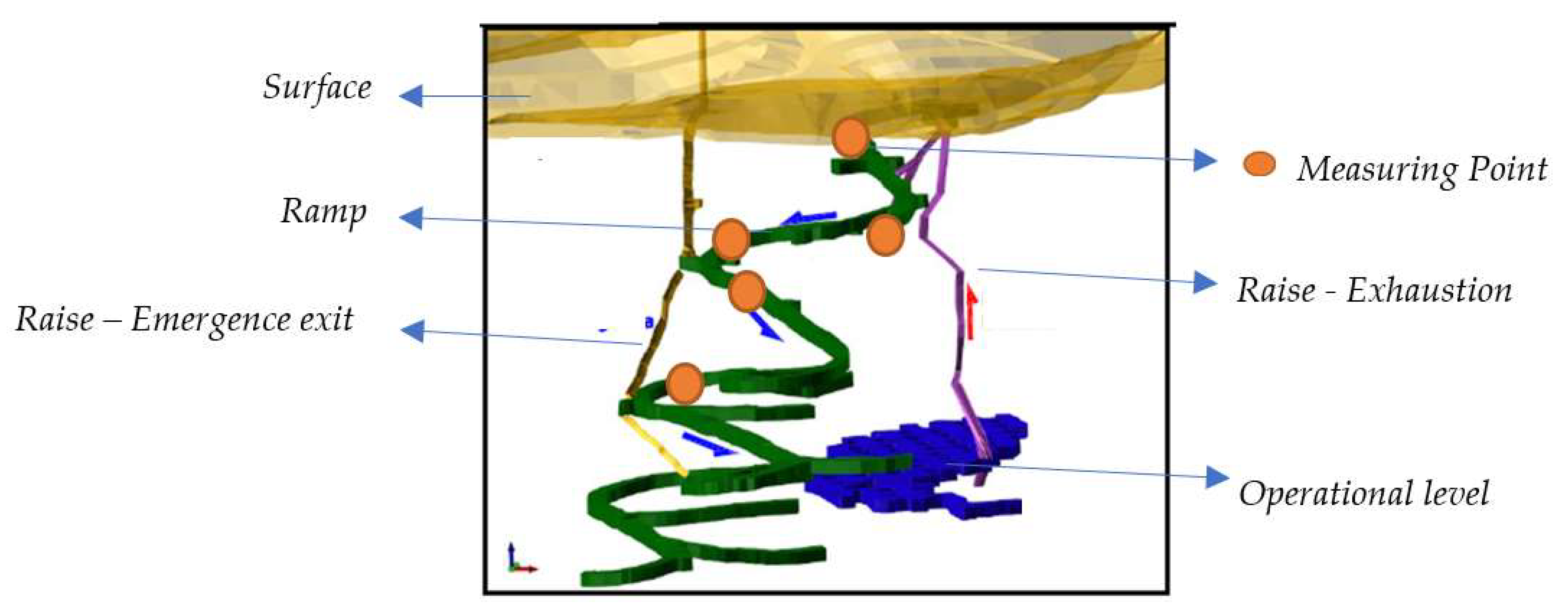
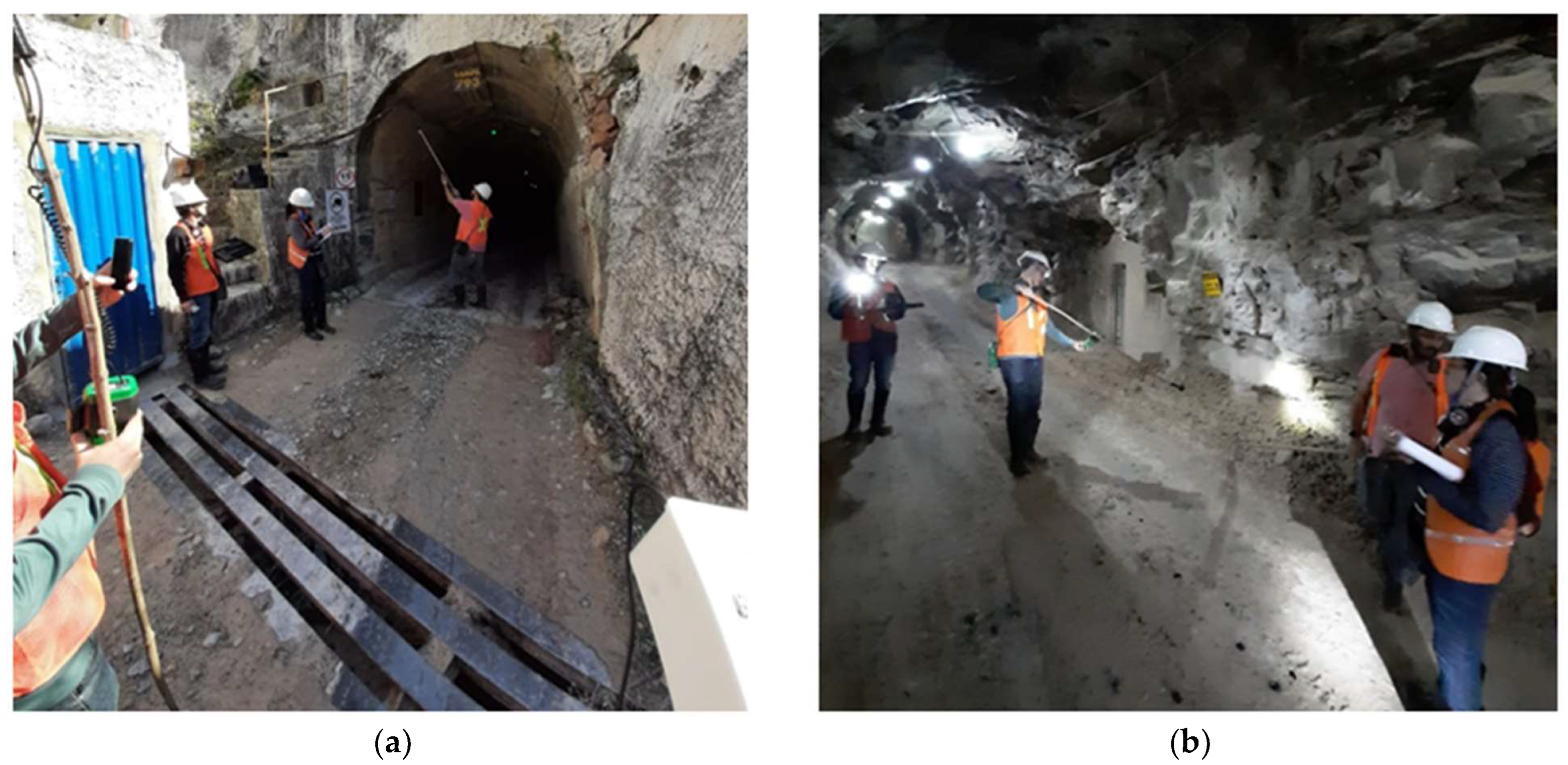

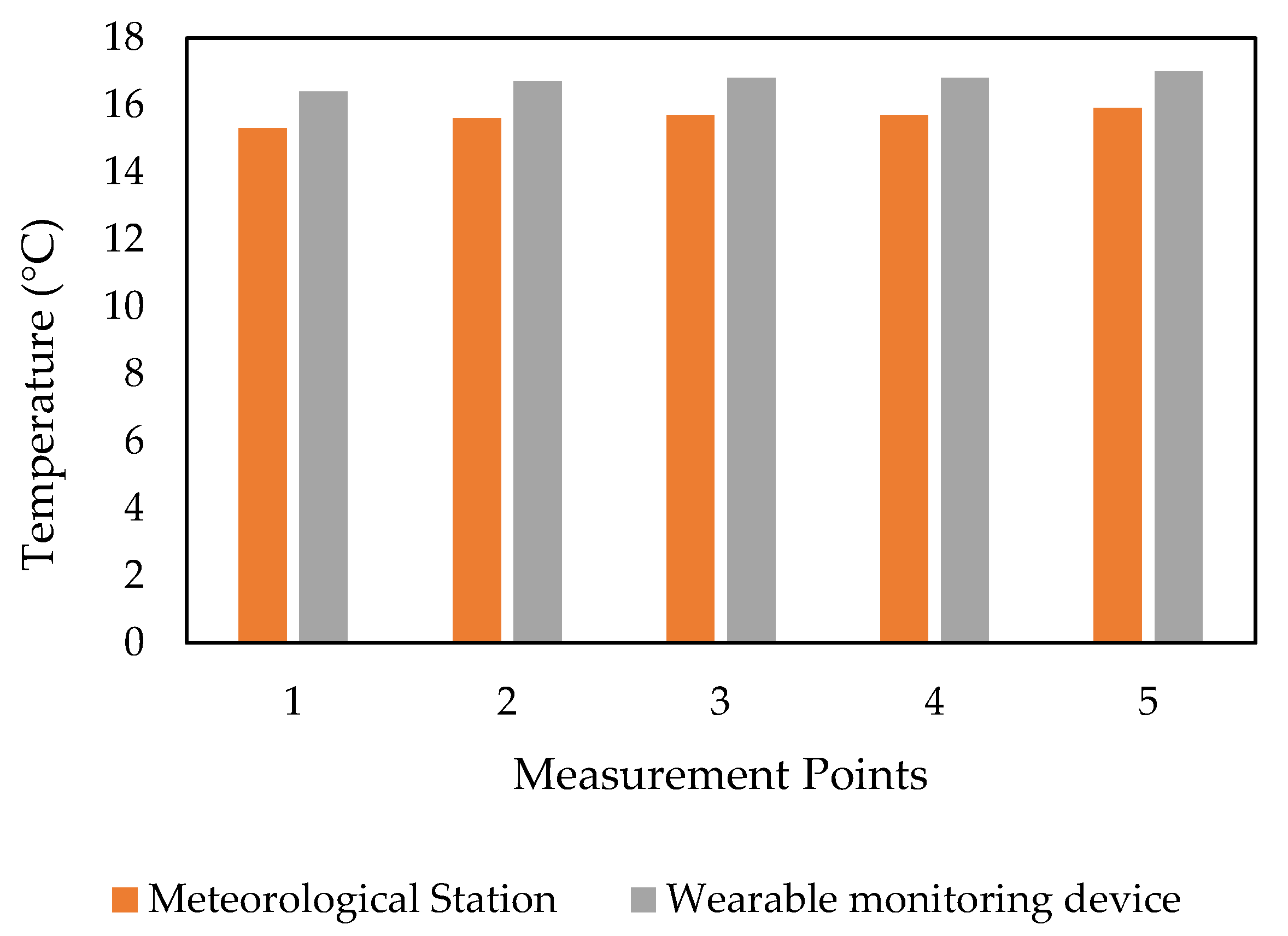
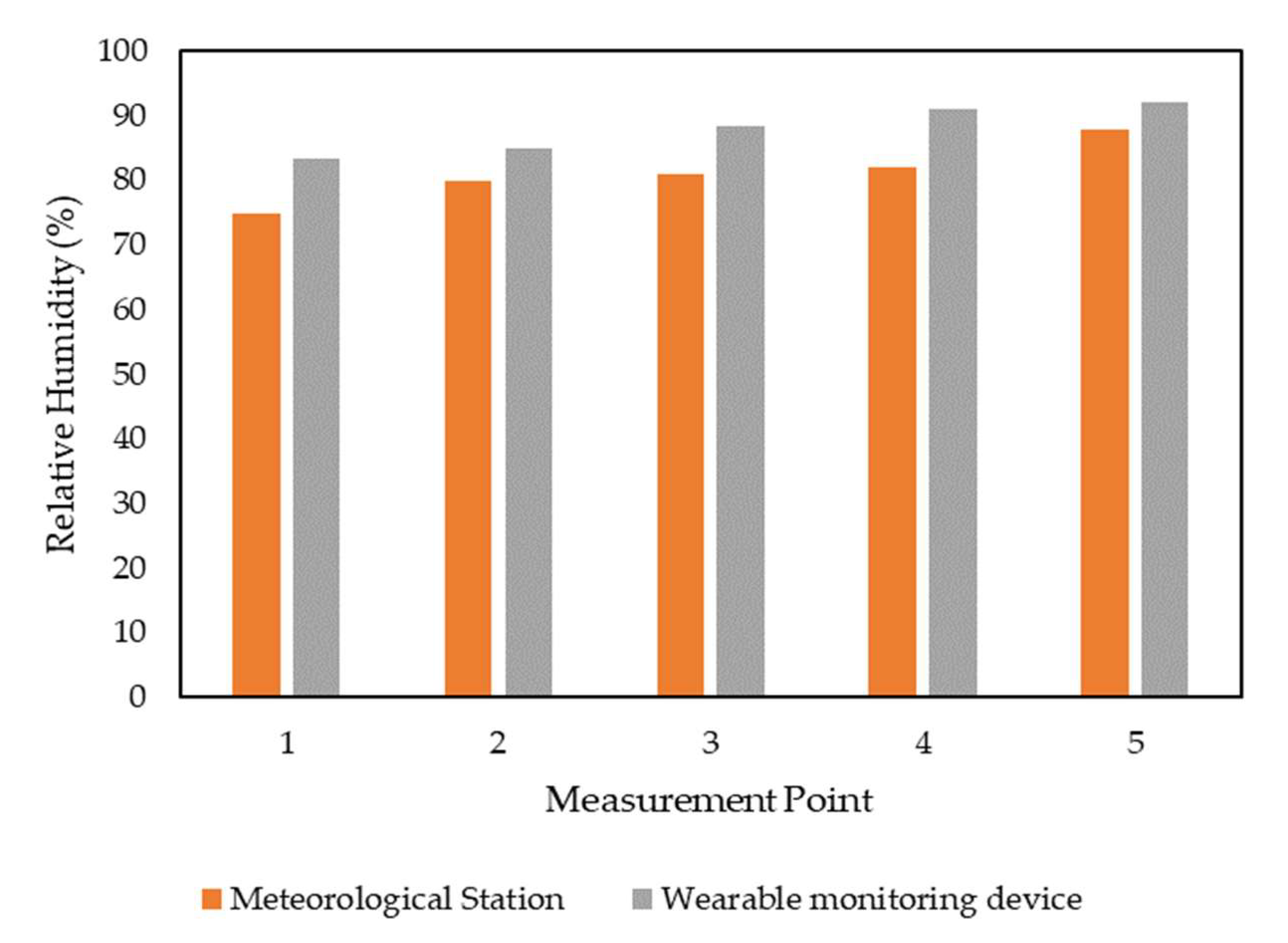
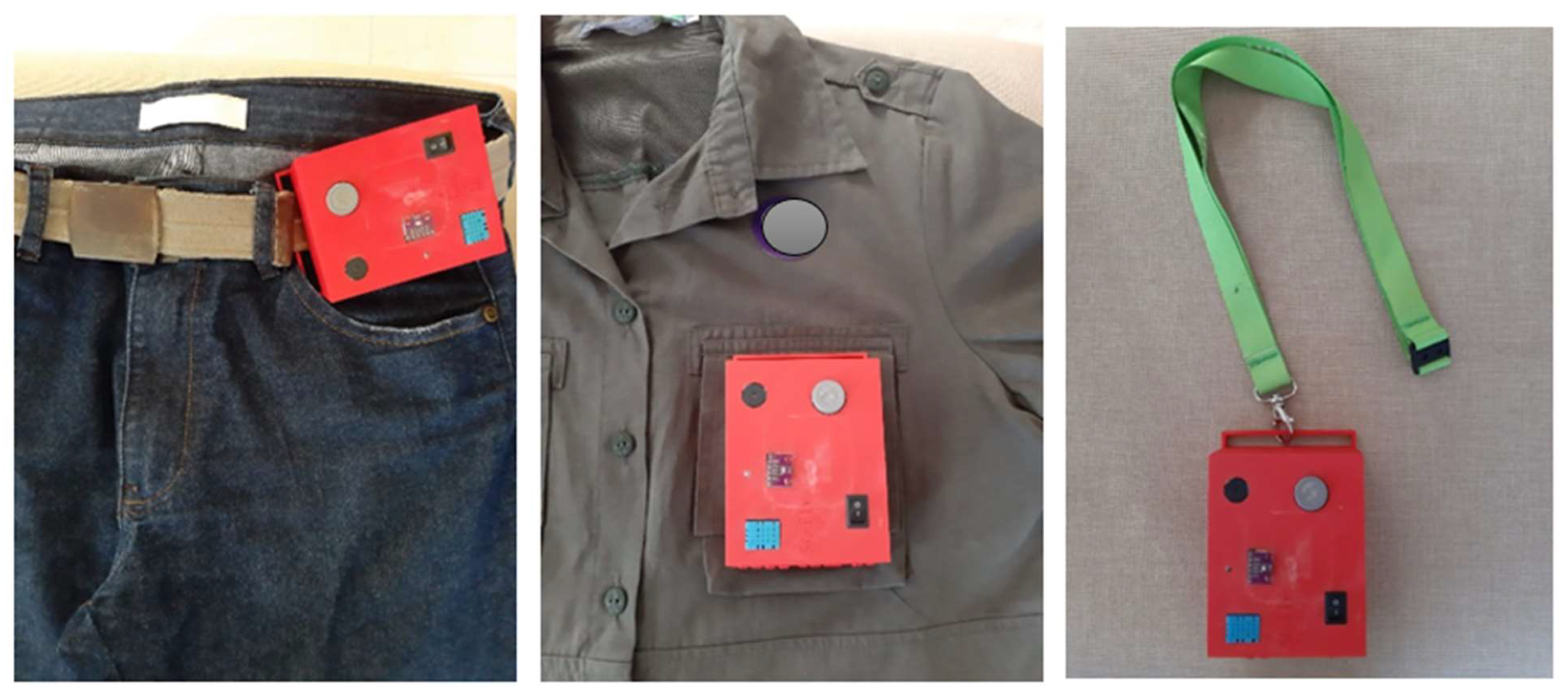

| Point | Meteorological Station | Wearable Monitoring Device | ||||
|---|---|---|---|---|---|---|
| Relative Humidity | Temperature | Pressure | DTH11 | BMP280 | BMP280 | |
| % RH | °C | hPa | RH% | °C | hPa | |
| 1 | 75 | 15.3 | 937.6 | 83.4 | 16.4 | 939.7 |
| 2 | 80 | 15.6 | 938.7 | 85.0 | 16.7 | 940.8 |
| 3 | 81 | 15.7 | 939.6 | 88.5 | 16.8 | 941.7 |
| 4 | 82 | 15.7 | 940.8 | 91.1 | 16.8 | 943.0 |
| 5 | 88 | 15.9 | 941.9 | 92.0 | 17.0 | 944.1 |
Publisher’s Note: MDPI stays neutral with regard to jurisdictional claims in published maps and institutional affiliations. |
© 2022 by the authors. Licensee MDPI, Basel, Switzerland. This article is an open access article distributed under the terms and conditions of the Creative Commons Attribution (CC BY) license (https://creativecommons.org/licenses/by/4.0/).
Share and Cite
Santos, R.d.C.P.; da Silva, J.M.; Junior, W.A.; Pinto, C.L.; Oliveira, M.M.; Mazzinghy, D.B. Development of a Low-Cost Device for Monitoring Ventilation Parameters (Temperature, Humidity and Pressure) in Underground Environments to Increase Operational Safety Using IoT. Mining 2022, 2, 746-756. https://doi.org/10.3390/mining2040041
Santos RdCP, da Silva JM, Junior WA, Pinto CL, Oliveira MM, Mazzinghy DB. Development of a Low-Cost Device for Monitoring Ventilation Parameters (Temperature, Humidity and Pressure) in Underground Environments to Increase Operational Safety Using IoT. Mining. 2022; 2(4):746-756. https://doi.org/10.3390/mining2040041
Chicago/Turabian StyleSantos, Rita de Cassia Pedrosa, José Margarida da Silva, Walter Albergaria Junior, Claudio Lúcio Pinto, Michel Melo Oliveira, and Douglas Batista Mazzinghy. 2022. "Development of a Low-Cost Device for Monitoring Ventilation Parameters (Temperature, Humidity and Pressure) in Underground Environments to Increase Operational Safety Using IoT" Mining 2, no. 4: 746-756. https://doi.org/10.3390/mining2040041
APA StyleSantos, R. d. C. P., da Silva, J. M., Junior, W. A., Pinto, C. L., Oliveira, M. M., & Mazzinghy, D. B. (2022). Development of a Low-Cost Device for Monitoring Ventilation Parameters (Temperature, Humidity and Pressure) in Underground Environments to Increase Operational Safety Using IoT. Mining, 2(4), 746-756. https://doi.org/10.3390/mining2040041







